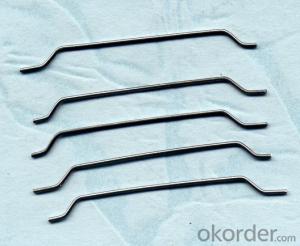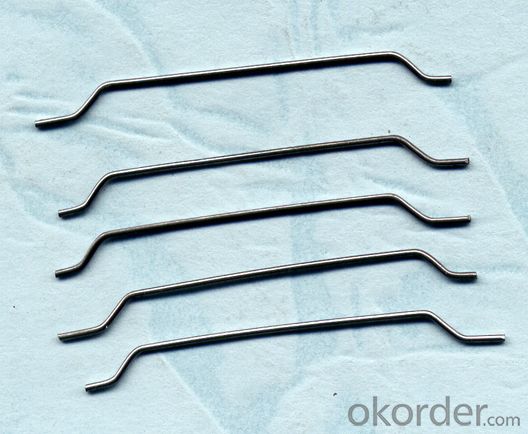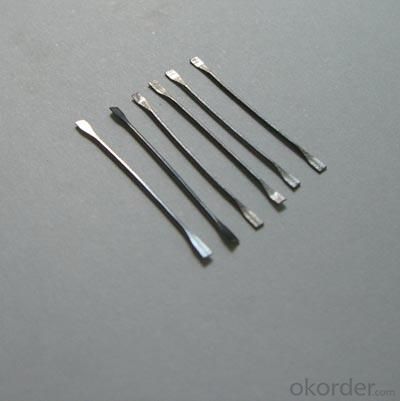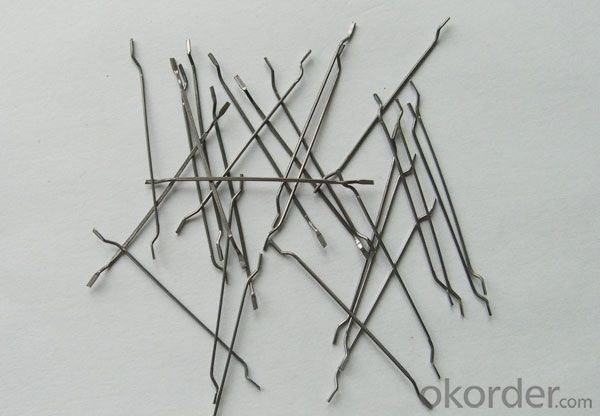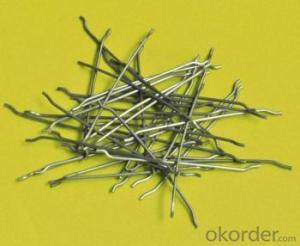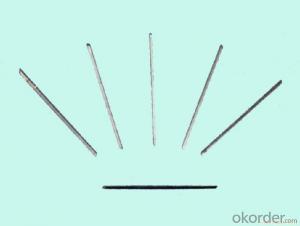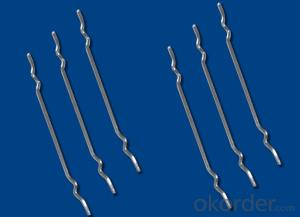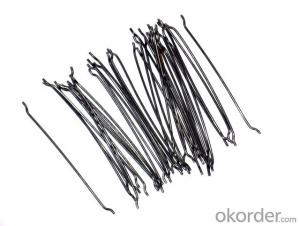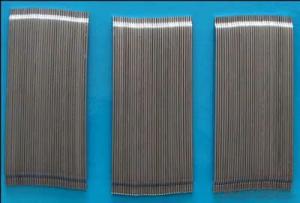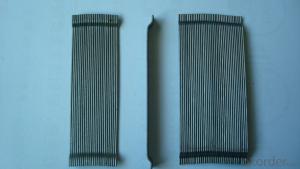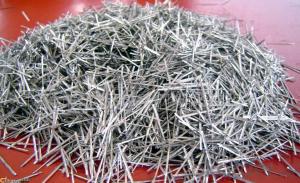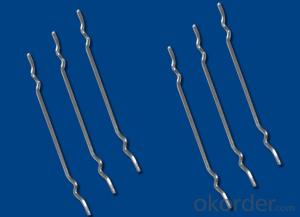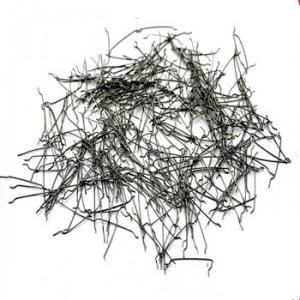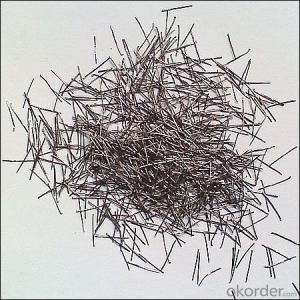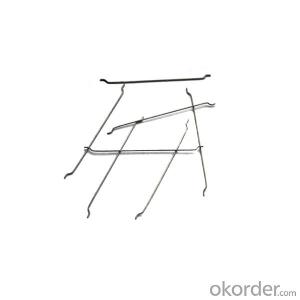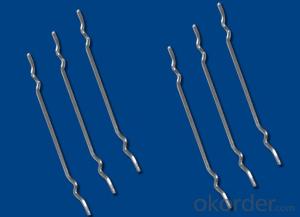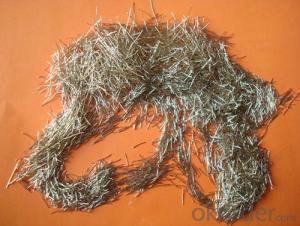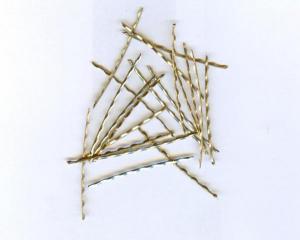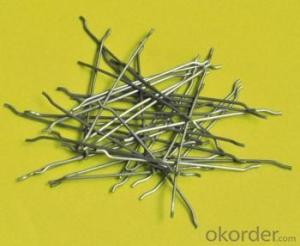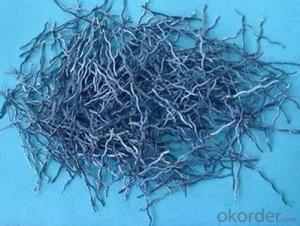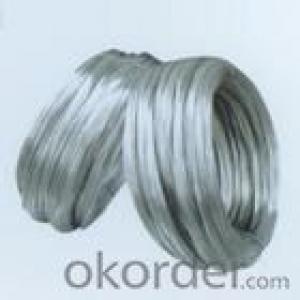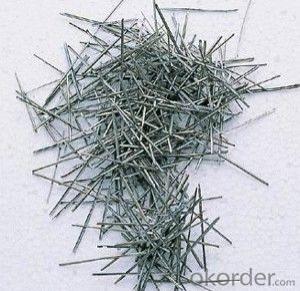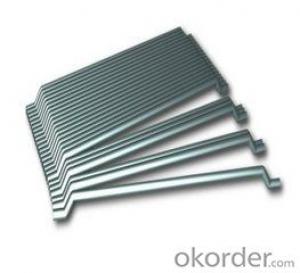Melt Extract Stainless Steel Fiber for Concrete Reinforcement Glued in a Row
- Loading Port:
- Tianjin
- Payment Terms:
- TT OR LC
- Min Order Qty:
- 5 m.t.
- Supply Capability:
- 30000 m.t./month
OKorder Service Pledge
OKorder Financial Service
You Might Also Like
Quick Details
Place of Origin: Hebei, China (Mainland)
Model Number: CW04
Material: Steel
Material:: Steel,low carbon steel wire
Standard:: ASTM ,ISO9001,CE
Shape:: hooked ends and straight middle
Grade:: Q195
Application:: shortcrete on tunnel, underground project, dam plate
Tensile strength:: 1100MPA to 2850Mpa
Demension:: per your requirement
Delivery Detail:: in 7 days upon receive prepayment
The products
Steel fiber for Concrete Reinforcement
1.High tensile strength
2.Length 6-60mm
3.Diameter 0.2-1.0mm
4.ISO9001, CE, TUV
Specifications
Specification | Diameter (mm) | Length (mm) | Aspect ratio (L/D) | Tensile strength (Mpa) |
0.12/6 | 0.12 | 6 | 50 | 2500 |
0.2/6 | 0.2 | 6 | 30 | 2500 |
0.2/13 | 0.2 | 13 | 65 | 2500 |
0.3/25 | 0.3 | 25 | 83 | 2500 |
0.4/25 | 0.4 | 25 | 63 | 1200 |
0.4/30 | 0.4 | 30 | 75 | 1200 |
0.5/30 | 0.5 | 30 | 60 | 1100 |
0.5/25 | 0.5 | 25 | 50 | 1100 |
0.55/25 | 0.55 | 25 | 45 | 800 or 1000 |
0.6/30 | 0.6 | 30 | 50 | 1000 or 1100 |
0.7/30 | 0.7 | 30 | 43 | 1000 |
0.7/35 | 0.7 | 35 | 50 | 1000 |
0.75/35 | 0.75 | 35 | 47 | 1000 |
0.75/60 | 0.75 | 60 | 80 | 1000 |
0.8/60 | 0.8 | 60 | 75 | 1000 |
0.9/50 | 0.9 | 50 | 56 | 1000 |
0.9/60 | 0.9 | 60 | 67 | 1000 |
1.0/50 | 1.0 | 50 | 50 | 1000 |
1.0/60 | 1.0 | 60 | 60 | 1000 |
Picture
PP bag
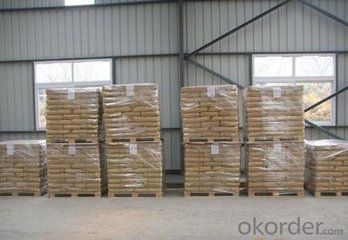
pakage
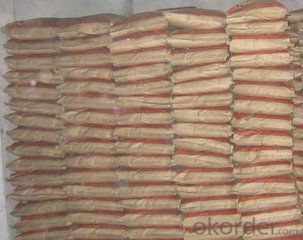
any type steel fiber
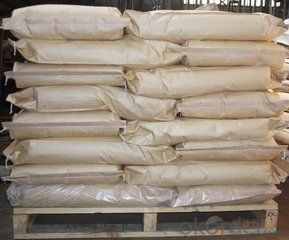
FAQ
steel fiber for concrete reinforcement glued steelfiber in a row>1200Mpa
- Q: Can melt extract stainless steel fiber be used in high-density concrete?
- Yes, melt extract stainless steel fiber can be used in high-density concrete. Stainless steel fibers are commonly added to concrete mixes to improve the overall strength, durability, and crack resistance of the concrete. The high-density concrete, which is typically used in applications where a denser and stronger material is required, can benefit from the addition of stainless steel fibers. These fibers help to reinforce the concrete and enhance its ability to withstand heavy loads, impact, and other stressors. Additionally, stainless steel fibers have excellent corrosion resistance properties, making them suitable for use in high-density concrete that may be exposed to harsh environmental conditions. Overall, the use of melt extract stainless steel fibers in high-density concrete can result in a stronger and more durable material that is better suited for demanding applications.
- Q: Can melt extract stainless steel fiber be used in the construction of precast concrete walls?
- Yes, melt extract stainless steel fiber can be used in the construction of precast concrete walls. These fibers can enhance the strength and durability of the concrete, reduce cracking, and improve the overall performance of the precast walls.
- Q: What is the effect of melt extract stainless steel fiber on the crack resistance of concrete?
- The use of melt extract stainless steel fiber in concrete has a significant effect on the crack resistance of the material. Stainless steel fibers are added to concrete mixes to enhance its overall mechanical properties, including crack resistance. One of the main benefits of using melt extract stainless steel fiber is its ability to improve the tensile strength and ductility of concrete. The fibers act as reinforcement within the concrete matrix, effectively bridging cracks that may occur due to shrinkage or external loads. This bridging effect helps to prevent crack propagation and increase the overall crack resistance of the concrete. The addition of stainless steel fibers also improves the overall durability of concrete. Due to their corrosion resistance properties, these fibers can withstand harsh environments, including exposure to chemicals, moisture, and temperature variations. This durability helps to preserve the integrity of the concrete and reduce the likelihood of cracks forming over time. Moreover, melt extract stainless steel fibers also contribute to the overall energy absorption capacity of the concrete. The fibers absorb energy during loading and distribute it throughout the structure, reducing the concentration of stress in specific areas and minimizing the formation and propagation of cracks. In summary, the inclusion of melt extract stainless steel fiber in concrete significantly enhances its crack resistance. These fibers improve the tensile strength, ductility, and durability of the material, effectively bridging cracks and preventing their propagation. By improving the crack resistance, stainless steel fibers contribute to the overall longevity and performance of concrete structures.
- Q: What is the effect of melt extract stainless steel fiber on the modulus of rigidity of concrete?
- The addition of melt extract stainless steel fiber to concrete generally increases its modulus of rigidity. This is because the fibers help to improve the overall tensile strength and stiffness of the concrete matrix, resulting in a higher modulus of rigidity.
- Q: How does the aspect ratio of melt extract stainless steel fiber affect its performance?
- The aspect ratio of melt extract stainless steel fiber refers to the ratio of its length to diameter. A higher aspect ratio generally leads to improved performance of the fiber. This is because a higher aspect ratio allows for a greater surface area and better interlocking within the matrix material, resulting in enhanced mechanical properties such as increased tensile strength, improved crack resistance, and better overall reinforcement. Additionally, a higher aspect ratio can enhance the fiber's ability to distribute stress evenly, leading to improved durability and longevity.
- Q: How does the presence of melt extract stainless steel fiber affect the creep behavior of concrete?
- The presence of melt extract stainless steel fiber has a significant impact on the creep behavior of concrete. Creep refers to the gradual deformation of concrete under a sustained load over time. Melt extract stainless steel fibers, being a reinforcement material, enhance the tensile strength and overall performance of concrete. These fibers are typically added to the concrete mixture during the mixing process. The addition of these fibers creates a three-dimensional network within the concrete matrix, which helps to distribute the applied load more evenly. One of the main effects of melt extract stainless steel fibers is the reduction of creep in concrete. These fibers act as internal reinforcements, effectively restraining the movement and deformation of the concrete under load over time. The presence of these fibers helps to improve the long-term stability and durability of concrete structures, as it minimizes the creep-induced deformations. Moreover, the melt extract stainless steel fibers also enhance the cracking resistance of concrete. By reinforcing the concrete matrix, these fibers help to control the propagation of cracks, preventing them from becoming larger and reducing the potential for further damage. This is particularly important in structures that are subjected to high loads or thermal variations, as it helps to maintain the integrity of the concrete over time. In addition to reducing creep and improving cracking resistance, melt extract stainless steel fibers also contribute to the overall mechanical properties of concrete. These fibers increase the flexural strength, impact resistance, and fatigue resistance of concrete, making it more resistant to various types of loads and stresses. Overall, the presence of melt extract stainless steel fibers in concrete has a positive effect on the creep behavior of the material. It reduces the deformation under sustained load, improves cracking resistance, and enhances the overall mechanical properties of concrete, resulting in a more durable and long-lasting construction material.
- Q: How does melt extract stainless steel fiber improve the fatigue resistance of concrete?
- Melt extract stainless steel fiber improves the fatigue resistance of concrete by enhancing its strength and durability. The fibers act as reinforcement within the concrete matrix, distributing and dissipating stress more effectively. This reduces the formation and propagation of cracks, increasing the overall fatigue life of the concrete. Additionally, the high tensile strength and corrosion resistance of stainless steel fibers provide long-term structural stability, making the concrete less prone to failure under cyclic loading conditions.
- Q: How is melt extract stainless steel fiber produced?
- Specialized manufacturing processes are used to produce melt extract stainless steel fiber. Initially, high-quality stainless steel alloy is melted in a furnace at extremely high temperatures. The molten steel is then forced through a spinneret, which is a fine nozzle with multiple small holes. As the molten steel passes through these holes, it solidifies and forms thin fibers. After the fibers are formed, they are rapidly cooled and solidified by passing them through a cooling chamber or a quench bath. This ensures that the fibers maintain their desired shape and strength. Once cooled, the fibers are gathered and further processed to eliminate any impurities or contaminants. Typically, the collected stainless steel fibers are cut into shorter lengths to enhance their usability in various applications. They can also undergo additional processing to modify their surface properties, such as applying a protective layer or different surface treatments. The melt extract process allows for the production of stainless steel fibers that have consistent dimensions and properties. These fibers possess excellent tensile strength, corrosion resistance, and high thermal conductivity, making them suitable for a broad range of applications. They are commonly utilized in industries such as concrete reinforcement, refractories, filtration systems, and as conductive additives.
- Q: What is the effect of melt extract stainless steel fiber on the carbonation resistance of concrete?
- The use of melt extract stainless steel fiber in concrete has a positive effect on the carbonation resistance of the material. Stainless steel fibers are known for their high corrosion resistance, which helps protect the concrete from carbonation. Carbonation is a process in which carbon dioxide from the atmosphere reacts with the calcium hydroxide in the concrete, forming calcium carbonate. This reaction can lead to a decrease in pH within the concrete, making it more susceptible to corrosion of the reinforcing steel. By incorporating melt extract stainless steel fibers into the concrete mix, the risk of carbonation is significantly reduced. The fibers act as a physical barrier, preventing the penetration of carbon dioxide into the concrete. This helps maintain a higher pH level within the material, protecting the reinforcing steel and enhancing the overall durability of the concrete structure. Additionally, the use of stainless steel fibers improves the mechanical properties of the concrete, such as its tensile strength and flexural strength. This further enhances the resistance of the material to carbonation and other environmental factors. In conclusion, the addition of melt extract stainless steel fibers to concrete significantly improves its carbonation resistance. This leads to increased durability, decreased maintenance requirements, and extended service life of concrete structures.
- Q: How does the addition of melt extract stainless steel fiber affect the workability of concrete?
- By incorporating melt extract stainless steel fiber, the workability of concrete can be significantly affected. These fibers, which are thin strands, are mixed into the concrete during the mixing process. Typically, they are added in small percentages ranging from 0.5% to 2% by volume. When stainless steel fibers are added to concrete, one of the primary outcomes is an enhancement in workability. Workability, in this context, refers to how easily concrete can be mixed, placed, and finished. By improving the cohesiveness and flowability of the concrete mixture, stainless steel fibers make it more manageable and manipulable during construction. These fibers serve as reinforcement agents within the concrete, increasing its resistance to cracking, shrinkage, and deformation. Consequently, the overall strength and durability of the concrete are improved, making it more resilient against external forces and environmental conditions. Furthermore, the addition of stainless steel fibers can also improve the plasticity of the concrete, leading to better compaction and consolidation. As a result, the hardened concrete attains increased density and reduced porosity, thereby enhancing mechanical properties like compressive strength and flexural strength. Nevertheless, it is important to acknowledge that adding stainless steel fibers can also present some challenges to the workability of concrete. The fibers may cause the mixture to become slightly sticky, making it more difficult to handle and place. Additionally, the presence of fibers can increase the viscosity of the concrete, making it harder to pump and transport. In conclusion, by adding melt extract stainless steel fiber to concrete, its workability can be positively influenced through improved cohesiveness, flowability, and plasticity. Nonetheless, careful consideration of dosage and mix design is necessary to ensure that the desired workability is achieved without compromising other concrete properties.
Send your message to us
Melt Extract Stainless Steel Fiber for Concrete Reinforcement Glued in a Row
- Loading Port:
- Tianjin
- Payment Terms:
- TT OR LC
- Min Order Qty:
- 5 m.t.
- Supply Capability:
- 30000 m.t./month
OKorder Service Pledge
OKorder Financial Service
Similar products
Hot products
Hot Searches
Related keywords
